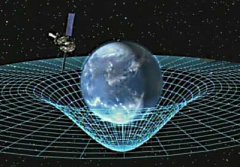
One of those fundamental assumptions has to do with the very nature of gravity itself. General relativity says that what we perceive as the force of gravity isn’t really a force at all. It is merely a consequence of the way that mass warps spacetime, which is a four-dimensional construct that combines the three typical dimensions of space (length, width, and height) with time. While this assumption produces all sorts of testable predictions that have been confirmed experimentally, the assumption itself has never been directly confirmed…until now.
In April of 2004, Gravity Probe B started circling the earth from pole to pole. It did so for 15 months, and all the while, precise observations were made of four gyroscopes that were roughly the size of ping-pong balls. The gyroscopes were covered with a superconducting surface. Once they started spinning, they each produced a nice magnetic pointer. Those pointers were actually able to measure two effects that the earth’s mass has on the surrounding spacetime.
In Newtonian mechanics, a gyroscope free from external forces would never change the direction in which it points. However, that prediction assumes that space and time are absolute. If mass warps space and time, it would cause the gyroscope to change the direction in which it points as it travels through space near a massive object. So as Gravity Probe B orbited the earth, the direction in which its gyroscopes pointed would not change if the earth were not warping spacetime, and it would change if the earth were warping spacetime.
Now this change is incredibly small, which is why Gravity Probe B used four gyroscopes instead of just one. That way, there was redundancy to the measurement. In the end, when the data from the gyroscopes were analyzed, their directions changed to within 0.28% of what general relativity predicts.2 That’s a pretty stunning confirmation of one of general relativity’s major assumptions!
The fact that mass warps spacetime is called the geodetic effect, and it is illustrated in the drawing above. However, you can illustrate it yourself by taking a bowling ball and placing it on a bed that has a sheet on it. The bowling ball will sink into the bed, “warping” the sheet. If you imagine the sheet as spacetime and the bowling ball as a large mass source (such as a planet), then you have the geodetic effect.
With that image in your head, you can visualize the other thing that Gravity Probe B confirmed. Imagine spinning the bowling ball as it sat on the bed. That simulates the rotation of a planet as it spins on its axis. What will happen to the sheet? As long as the sheet and ball aren’t really slick, the sheet will twist along with the bowling ball. This is called frame dragging, and it is predicted by general relativity. Now it turns out that frame dragging is significantly harder to measure than the geodetic effect. Nevertheless, Gravity Probe B did confirm that it is happening. Unfortunately, due to experimental issues, the confirmation is only to within 20% of what general relativity predicts.2
Put together, these are strong confirmations for Einstein’s Theory of General Relativity. However, things aren’t completely rosy. Quantum mechanics is also backed up by an enormous amount of experimental evidence. However, general relativity and quantum mechanics cannot both be completely correct, since they contradict each other on certain fundamental assumptions about the nature of space and time. Thus, there is either something wrong with general relativity, something wrong with quantum mechanics, or something wrong with both.
My bet is on the last option.
REFERENCES
1. N. Ashby and M. Weiss, “Global Positioning Receivers and Relativity,” NIST Technical Note 1385, U.S Government Printing Office, March 1999
Return to Text
2. “At Long Last, Gravity Probe B Proves Einstein Right,” Science, 332:649, 2011
Return to Text

Wow. Trying to figure this out is almost making my brain hurt. It kind of makes some kind of sense, but I’m trying to figure what kind of calculations one would have to do to come up with this. Wow.
The math is truly incredible. I can do some of the basic general relativity calculations, but a lot of it goes beyond my abilities. I am really impressed with people like Russell Humphreys, who fully understand the mathematics.
Very interesting post. Thanks for posting it.
BTW, in your final paragraph, should the second sentence read “However, things areN’T completely rosy”?
Thanks for noticing that, Michael. You are correct. Thing’s aren’t completely rosy. I have made the change.
“general relativity and quantum mechanics cannot both be completely correct, since they contradict each other on certain fundamental assumptions about the nature of space and time”
What are these fundamental assumptions they contradict each other on?
Mark, the biggest one is the nature of time. In quantum mechanics, time is just an unbiased arbiter. It ticks away without being affected by changing conditions. In general relativity, time is affected by changing conditions. For example, it ticks more slowly in high gravitational fields and ticks more quickly in low gravitational fields. A second contradiction is the result of the fact that general relativity assumes spacetime is continuous. Quantum mechanics says that even space is quantized.